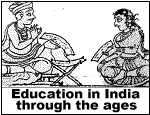Education of Gadiyaram R. Sharma
An Oral Account of Education in Andhra Pradesh in Early 1900s
Prologue:
"Sometimes they would bring us wood or stone boards with alphabets carved in them and we had to run our fingers through the grooves to practice good handwriting."
Upon my request in 1987, Shri Gadiyaram Ramakrishna Sharma of Alampur in Mehaboobnagar district of Andhra Pradesh, narrated his Gurukul (traditional Indian residential schooling) style education. I am grateful to him for providing insight into the Brahmanical education provided to young boys in Andhra Pradesh at the turn of the 19th century.
- Jyotsna Kamat
Last updated : December 07, 2024
![]()
I studied in the choultry (agrahara) of Biriwada under the sacred guidance
of Shri Veluri Shivarama Shastri. His holiness, my teacher himself provided me with rice,
and clothing in addition to education. We called his home "Gurukulumu"
(master's place) or "Devakulumu" (place of God or equivalent of
temple). I studied there for three years. Due to his teaching prowess and my learning
desire, I learned poetry, figure of speech in dramas (natyalankara), and
grammar very quickly. After that, for ten years I did self study. I never gave any
tuition (Guru Dukshina) to my Guru; he was a wealthy man; rich in knowledge and
in heart.
The teaching method encouraged development of memory power. The teacher taught the hymns from Vedas and Shastras (ancient Indian texts) by heart. We were asked to repeat after him for a long time. After a week or so, we could recite the hymns without the references. Since we had to repeat them so often, there was no way to forget them! Brahmacharya (celibacy compounded with discipline of food and thought) considerably improves the retaining power of the mind and we were expected to follow it strictly. Yoga (traditional Indian exercise for body and mind) was not mandatory, but each one of us religiously did several positions (asanas) , Surya Namaskara (an ten step exercise emphasizing flexibility and balance done in honor of the Sun God) , Pranayama (breathing techniques), Dharana, and Niyama. Some of my friends also practiced use of weapons, and wrestling.
The boys were taught to write after the fifth year. In the school, we were taught to write in the sand to practice alphabets. Sometimes they would bring us wood or stone boards with alphabets carved in them and we had to run our fingers through the grooves to practice good handwriting. We called them "Gunta-O-Namulu."
Once the boys learned the alphabets and combinations, they could write on palm leaves. There were also fruit leaves, cloths, and metal boards used for writing. We were made to write psalms, mathematical rules, and mythological stories.
Sometimes the older boys taught the younger boys. We had to submit the homework that was assigned in the morning before the sunset. We had to follow the rigid rules of time and activity: Getting up at sunrise, yoga, personal grooming, prayer and worship, reading and study, lunch, spending time with the teacher (Guru Shushrooshe), Sandhyavandana, story listening, dinner, and going to bed in that strict order.
The school was off on the following days: the first day, the 8th day, the 14th day, the full moon day, and the Amavasya. On very cloudy days and if the teacher was busy discussing with visiting scholars, he would let us play instead of study.
During my childhood, in Andhra Pradesh there used to be "Vipra-vinodi"s. They are not Brahmins; neither are they Vipras. These boys learned hand skills like magic, black magic, and other tantric sciences.
The Koochipudi Bhagawats taught their children music, musical instruments, dance, and acting. The Bhagawats still practice this form of education in Andhra Pradesh.
When I was in the Guru's house, I got up at five o'clock and did the Sandhyavandana. I read the lessons of the day ahead of time. The teacher would start his lecture around 9 o'clock. After that the students got together under the trees and discussed the lessons, and regurgitated. After the sunset, if we had any doubts about the lesson, we would consult with the teacher. The students who came from outside villages went home and those who resided with the teacher would read Telugu poetry.
This
is how I was educated.
![]()
See Also:

